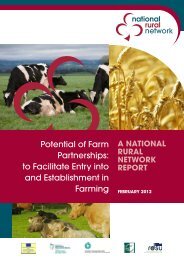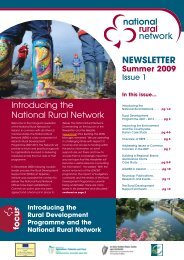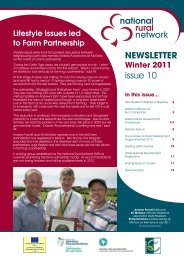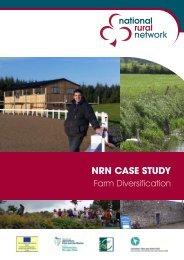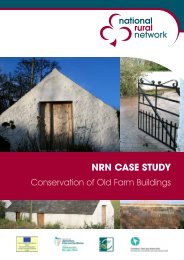Issue 15 Spring 2013 - National Rural Network
Issue 15 Spring 2013 - National Rural Network
Issue 15 Spring 2013 - National Rural Network
Create successful ePaper yourself
Turn your PDF publications into a flip-book with our unique Google optimized e-Paper software.
Anaerobic Digestion on Limerick Farm<br />
Farm-based anaerobic digestion is in its infancy in Ireland<br />
with less than a handful of plants. In Germany, the world<br />
leader, there are around 4,000 on-farm anaerobic digesters.<br />
There are less than 100 in the UK, with ambitious plans to<br />
increase to 1,000 by 2020.<br />
The McDonnell family, who farm outside Shanagolden in<br />
Co. Limerick, have installed one of the most advanced<br />
anaerobic digestion (AD) on-farm plants in the country.<br />
GreenGas AD is the only plant in Ireland currently selling<br />
electricity into the national grid.<br />
Brothers David and Richard McDonnell run a 300-cow dairy<br />
herd, supplying Kerry Group. They also run a free-range<br />
poultry enterprise, supplying chickens to Shannon Vale<br />
Foods in Clonakilty. A few years ago, they started looking at<br />
alternative energy and David visited a number of AD plants<br />
in Germany and Denmark.<br />
He engaged German company Krieg and Fischer, which<br />
has built over <strong>15</strong>0 AD plants worldwide, to design the plant.<br />
Construction was completed in 2010 and GreenGas AD<br />
went into commercial operation in early 2011.<br />
Management<br />
“It is a highly complex chemical, biological, mechanical<br />
and electrical process which requires management on a<br />
daily basis. It was a heavy investment and it would not be<br />
viable without grant-aid. We are meeting our financial targets<br />
and hope to have the investment re-paid within about eight<br />
years,” said David.<br />
As well as the AD plant, the McDonnells also installed two<br />
2.3MW wind turbines on their farm, which were connected<br />
to the national grid in late 2010. “We had the finance<br />
arranged before the collapse in 2008 otherwise we would<br />
probably never have been able to go ahead,” said David.<br />
Each turbine is potentially 10 times more powerful,<br />
depending on wind speeds, in terms of electricity generation<br />
than the AD plant. Last year, the two turbines delivered over<br />
12 times more electricity to the grid than the AD plant. All<br />
in all, the two alternative energy ventures must make the<br />
McDonnell farm among the most carbon efficient in the<br />
country.<br />
Electricity<br />
All animal slurry and litter from the poultry enterprise is<br />
used as feedstock for biogas production. Waste fruit and<br />
vegetables and waste from hatcheries are also sourced from<br />
around the locality. The biogas produced in the anaerobic<br />
digestion process is used as fuel in a combined heat and<br />
power (CHP) engine.<br />
The resultant electricity produced is sold to the national<br />
grid and the heat generated is recycled for heating in<br />
both the AD plant and the poultry enterprise. The electricity<br />
generated by the plant is the equivalent of the total annual<br />
consumption of around <strong>15</strong>0 homes.<br />
The by-product from the plant is used as fertiliser on the<br />
McDonnell and other farms in the locality. It has significant<br />
economic and environmental benefits, with better availability<br />
of nutrients and reduced odours.<br />
The ambitious project is the culmination of painstaking<br />
research and negotiation through very detailed regulatory<br />
requirements during the planning and plant set-up stages. It<br />
is an expensive and high tech operation.<br />
There are some 4,000 on-farm anaerobic digesters in<br />
Germany.<br />
Revised TAMS for Sheep<br />
The Minister for Agriculture, Food and the Marine Simon Coveney has introduced a revised TAMS (Targeted<br />
Agricultural Modernisation Scheme) for sheep. The revised scheme, which came into effect on 19 March <strong>2013</strong>,<br />
involves an increase in the investment ceiling per holding from €10,000 to €25,000. The grant rate remains<br />
unchanged at 40%.<br />
Approvals issued and grants paid under previous versions of the TAMS sheep fencing/handling scheme will be<br />
taken into account for the purposes of the new scheme. The number of items eligible for grant-aid under the<br />
scheme has been increased to include mobile meal feeders, hay racks, adoption units and tag readers.<br />
p8




